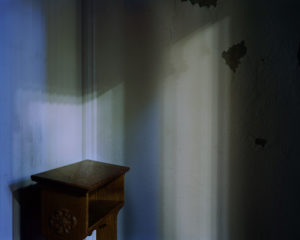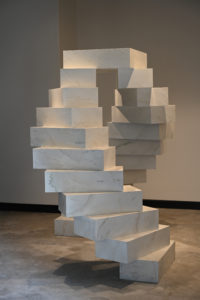Teresa Hubbard and Alexander Birchler. Flora, 2017. Synchronized double-sided film installation with shared soundtrack; thirty-minute loop. Collection of the Modern Art Museum of Fort Worth. On view September 5, 2021, to January 16, 2022.
WHEN FLORA, A DOUBLE-SIDED FILM INSTALLATION BY Teresa Hubbard and Alexander Birchler, premiered at the Swiss Pavilion of the fifty-seventh Venice Biennale in 2017, it immediately caught the public imagination. Resulting from Hubbard and Birchler’s long, patient research into the life of Flora Mayo, a young aspiring sculptor who had a brief affair with Alberto Giacometti in 1920s Paris before fading from public view, Flora weaves together several threads of Mayo’s story into a complex but seamless and moving whole.
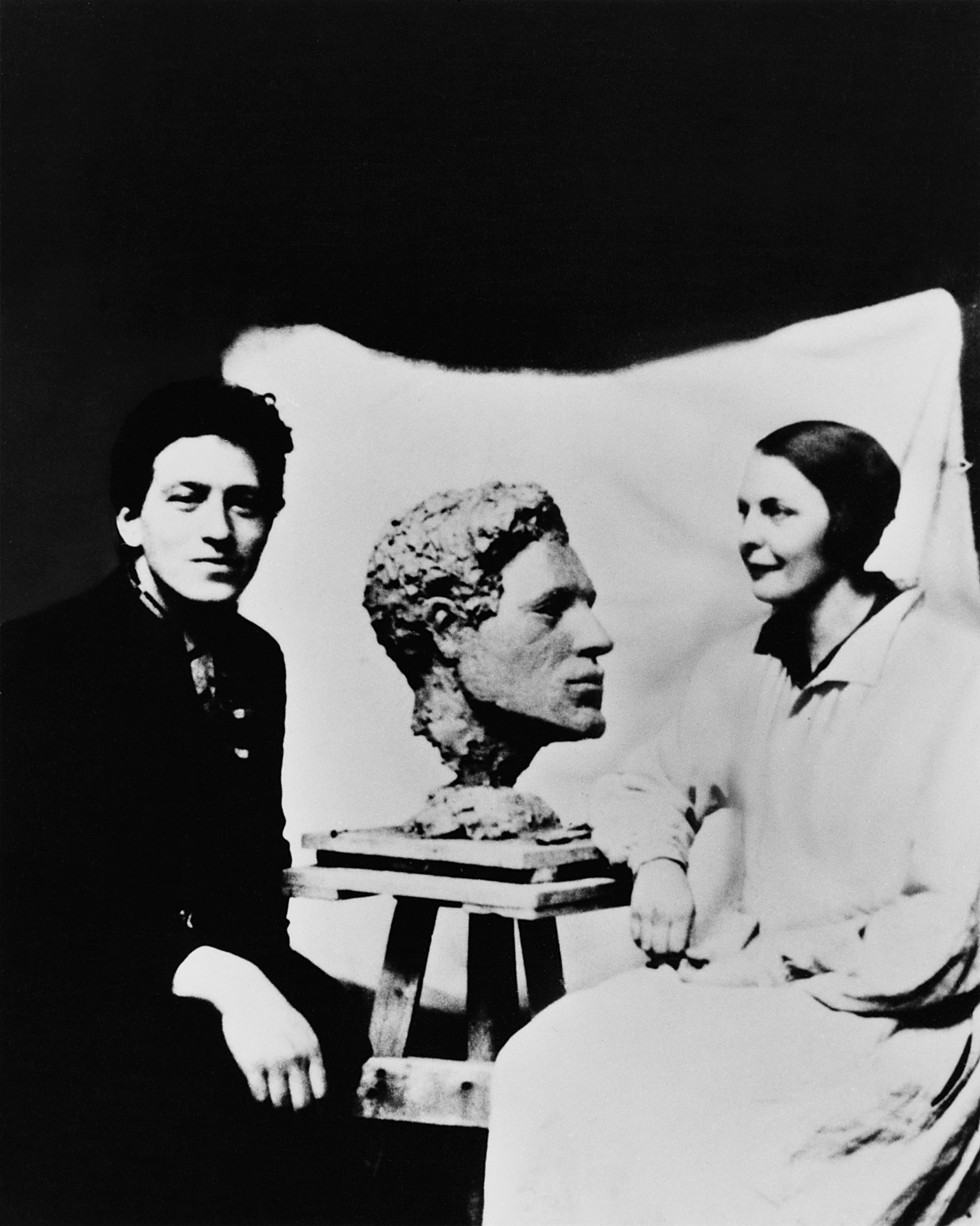
Teresa Hubbard and Alexander Birchler. Bust (installation detail), 2017. Framed silver gelatin print. 34½ x 28¼ inches. All images courtesy of the artists, Tanya Bonakdar Gallery, and Lora Reynolds Gallery.
In the installation, a single screen stands at the center of the room, and two separate films are projected onto it, one on each side, back to back. On one side, an actress filmed in black-and-white plays the part of the young Flora, living and working in her bohemian Paris studio in 1926. We see her circling her clay model, studying it closely, carefully building it up into what will become her portrait bust of Alberto. As her life and art intertwine, she receives a visit from Alberto (whose face we never see), sitting for his portrait. They smile and talk as she continues to work. The camera pans her romantically spartan garret, showing her models and art supplies. Period jazz plays on a phonograph in the background, as they pour glasses of wine and sit down for a simple candlelight dinner. They laughingly play a game, spinning eggs on the table. They get up to dance, with her bed in the background. They may not have much, but in that moment, they have youth, art, and each other’s love.
On the other side of the screen, in color, is Flora’s son David, now in his eighties, speaking to the camera at his home in the Southern California suburbs. Sorting through a collection of old photographs, he recalls his mother’s life. When the family money stopped coming, she had to return to the US, give up her artistic dreams, and take a series of difficult, low-paying jobs to support herself and her son. He drives to the down-at-the-heel, ironically named Versailles Apartments in Los Angeles to see where his mother landed on her return to the US.
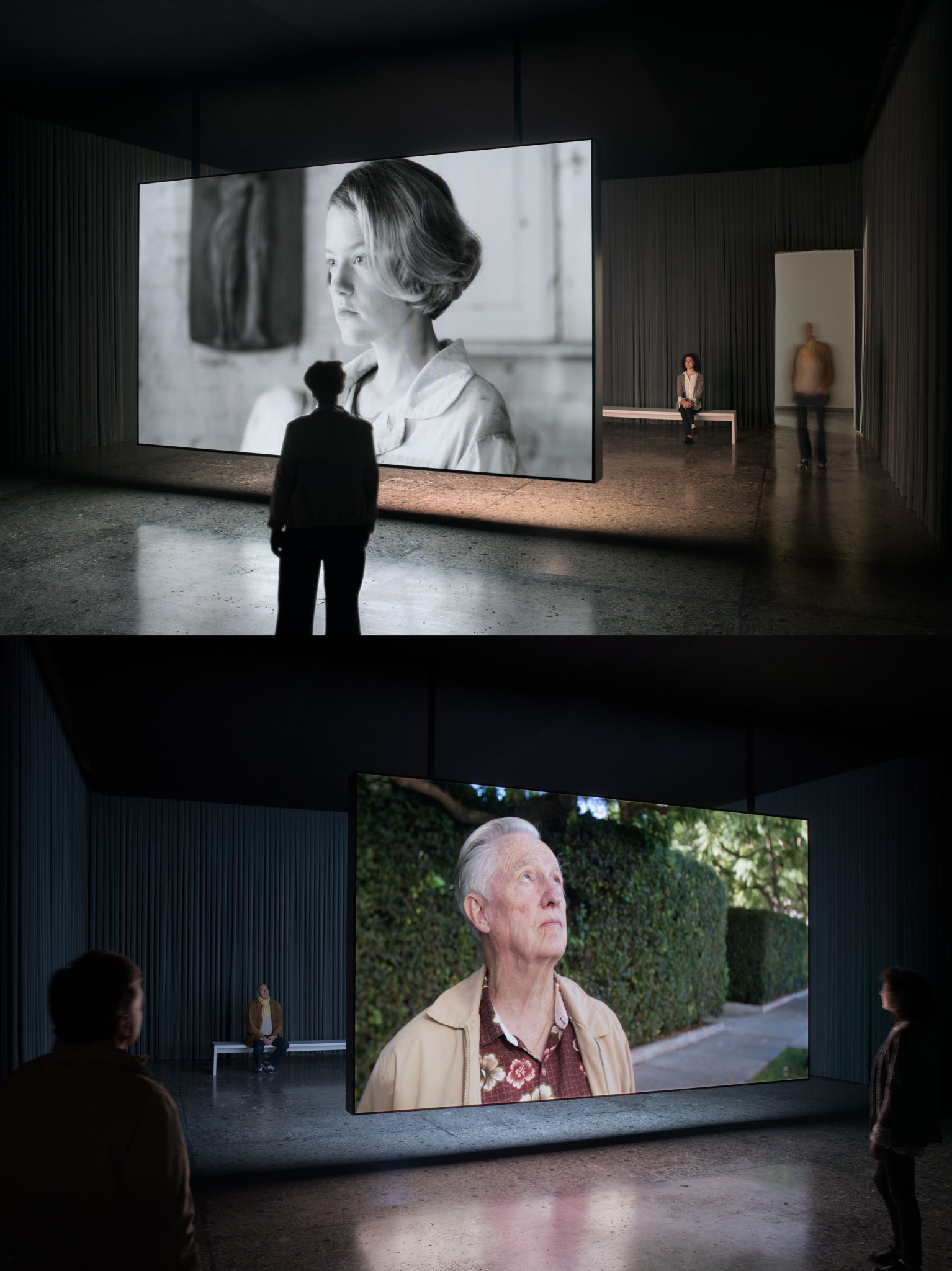
Teresa Hubbard and Alexander Birchler. Flora, 2017. Photo: Ugo Carmeni.
As the two films share a single soundtrack, viewing Flora is a complex experience. The soundtrack alternates between David speaking about his mother’s life and his memories of her, and a voiceover narration in which Flora recalls her life in Paris. However, a viewer can only watch one side of the screen at a time-either Flora’s or David’s. Thus, at any moment, the other person seems to be breaking in from elsewhere-either Flora’s voice entering David’s picture from the past, or David’s voice entering Flora’s picture from the future. The story is compelling enough to watch each thirty-minute video in full (thus hearing the soundtrack twice).
Before viewing Flora, however, the viewer is prepared by encountering Bust, a companion work by Hubbard and Birchler in the preceding gallery. Bust consists of two objects that draw the viewer into the art-historical puzzle that stimulated the research that ultimately produced Flora. The first is a small black-and-white photographic reproduction, whose caption hints at Flora Mayo’s obscurity:
Flora Mayo and Alberto Giacometti, with the bust she made of him, circa 1927. Photographer unknown. Original photograph belonging to Flora Mayo, kept under her mattress, lost. Film negative missing. Reproduction from only known duplicate print, archive of Fotostiftung Schweiz, Winterthur.
Hubbard and Birchler noticed this photograph published in James Lord’s biography of Giacometti, and it set them on Flora’s trail. Lord describes the photo this way:
A photograph has survived of the two young artists and lovers. Flora looks at her lover wistfully, as she had cause to do. She is attractive, but not beautiful, and there is something weak in her face. It must have been apparent, even then, that she was one of those destined to be destroyed by circumstances.
Lord’s shockingly dismissive cruelty motivated Hubbard and Birchler to dig deeper, ultimately leading to the creation of Flora. (There are some hints that Lord may be responsible for the missing negative.)
The other component of Bust is a reconstruction of the bust that we see in the photograph. Though no other trace of the original work survives, with sophisticated 3D-modeling technology, the photo-plus guidance from some additional photos of Giacometti-was enough to create a mold to recast the work. Its caption reads:
Original clay bust portrait of Alberto Giacometti by Flora Mayo, lost. Reconstructed and cast in brass.
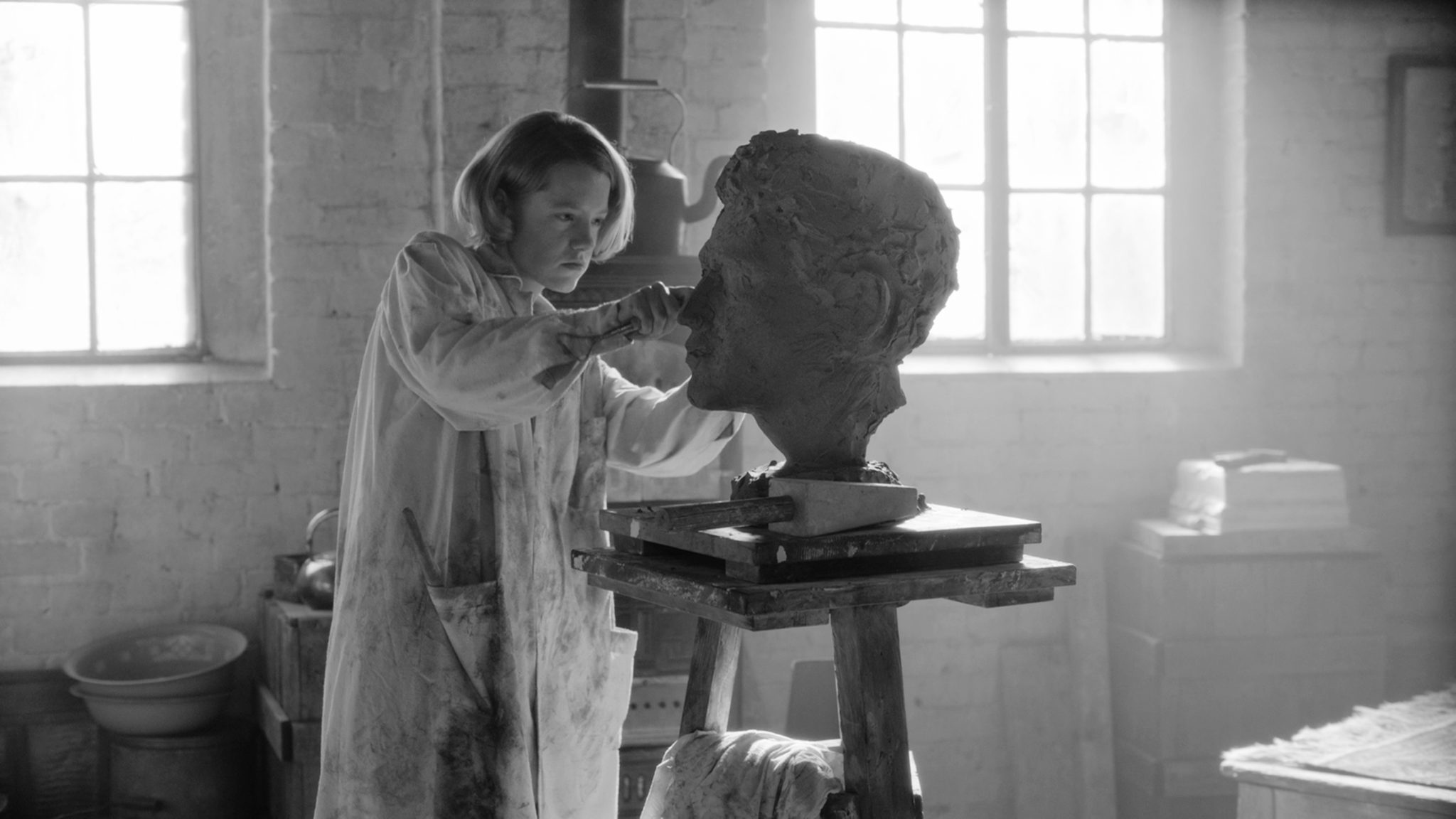
Teresa Hubbard and Alexander Birchler. Flora (installation detail), 2017.
What does all of this add up to? From one perspective, it amounts to an extraordinarily rich and detailed portrait-one that takes full advantage of its technological medium. Whereas a painted portrait can only hint at the complexities of its subject, in Flora, the combination of reenactment, interview, and the apparatus of historical research gives us a fully rounded picture of a woman whose life had previously been reduced to a footnote in history. It’s possible to view Flora straightforwardly as a matter of balancing the books: once, the career of a young artist was derailed by sexism and misfortune; now justice can be done and Flora Mayo’s reputation restored.
While that is quite true, the film is so memorable because it invites viewers to think more deeply about the questions of value that lie beyond and beneath the matter of public reputation. As we ponder Flora Mayo’s life, we are given cause to think about: what it means for one’s life to be shaped by one’s loves; what art is for; why some people make works of art and other people preserve and care for them; how one is remembered after death; and what it means to do someone justice.
The story of Flora Mayo’s life is animated by the energy of love, generated along the axes of two relationships: her brief, youthful affair with Alberto Giacometti, and the lifelong love between mother and son, as told by David Mayo. First, the film shows us the love affair and its consequences-not only through the black-and-white filmed reenactment, but also through the artifacts it produced. When two sculptors fall in love, they are joined as one flesh like other lovers-but their medium also lets them immortalize their love through handmade, tangible artifacts, as Flora and Alberto did with their respective portrait busts-for he sculpted her too. But of course, the two artifacts met very different fates.
Valued by modernist art historiography for its formal creativity and innovation, Alberto’s work is well preserved in museums and history books. His painted plaster bust of Flora has a simplified, flattened shape, with crudely scratched lines to indicate facial features and roughly modeled hair. In its raw, energetic simplicity, it recalls the archaic, primitive predecessors (for example, Cycladic art) with which modernist artists sought to reinvigorate the tradition. Now known as Head of a Woman (Flora Mayo), it resides in the collection of the Giacometti Foundation in Paris and was recently exhibited at the Guggenheim in New York. In Flora, we glimpse two art handlers at the Giacometti Foundation carefully placing it in a custom crate and loading it into a van for transport to another exhibition-implicit in all of this is its enormous cost. Flora’s work, by contrast, is not valued by historiographical canons; its classical, academic style lacks Alberto’s formal innovation. Her bust of Alberto was lost when she left Paris; now it only exists in the form of the reproduction made by Hubbard and Birchler.
Does Hubbard and Birchler’s work imply that we should reevaluate Flora Mayo’s status as an artist in the judgment of history, perhaps by revising the inherited modernist canon to include categories such as identity? That is possible, and yet, in responding to Flora, my urge is to put questions of institutional canons entirely to the side, in favor of the more emotionally compelling claims of personal value based on love and intimacy. (In an interview with Christina Végh, Hubbard and Birchler have also said they are not interested in the question of whether she was “a good artist.”)
Yes, it’s true, I think, that sufficiently original formal innovation, à la Giacometti, will indeed reward an artist with fame, fortune, and a place in art history. But is that what really matters in life? Isn’t it better to have the love of your children and a work of art made in your honor by your beloved than all the museum retrospectives in the world? To be clear, I don’t claim that Flora presumes to answer such questions; rather, it is rich enough to allow them to float into the viewer’s mind and remain there.
The love between Flora and her son endured over the entirety of her life. David’s understated manner as he tells the camera of her life after Paris makes his stories of her later hardships all the more forceful. With her allowance exhausted, under a cloud of family disapproval, a young woman who had been raised in wealth and privilege now looked ahead only to hard physical work. She reluctantly accepted social welfare funds, as she struggled to make ends meet as a single mother.
The most moving parts of David’s story concern the two-sided, unselfconscious, self-sacrificial love between mother and son. Although Flora had worked hard to support David during his childhood, cleaning toilets and mopping floors as a janitor, by the time he started college, she was no longer able to continue-so he abandoned his education to help support her. The paradox is familiar to any parent or caregiver: nothing obstructs one’s plans for personal fulfillment more than a needy dependent, and yet sacrifice makes possible an entirely different kind of fulfillment that could never have happened otherwise.
The climax of David’s side comes when he reads aloud another cruel passage from Lord’s biography, this one describing Flora’s final meeting with Alberto toward the end of her life: “Now she was a poor old woman to whom he could offer only the proof that his life had not been for nothing.… Flora, before long, went back to California where she ended her days in demented solitude.” Hearing David quietly defend his mother (“I’m just very proud of her”), a viewer might be led to ask: Who needs the art world, if these are the values it embraces? What is wrong with this picture? Who cares what James Lord thinks, anyway?
After exploring the resonances of Flora’s loves, the film moves toward considerations of legacy and mortality. What, ultimately, do we leave behind after we die? Flora does go some way toward restoring Flora’s reputation from oblivion. And yet, does the logic of the film subtly relativize such considerations? Like that of the mighty Ozymandias, all worldly fame will ultimately fade. What then?
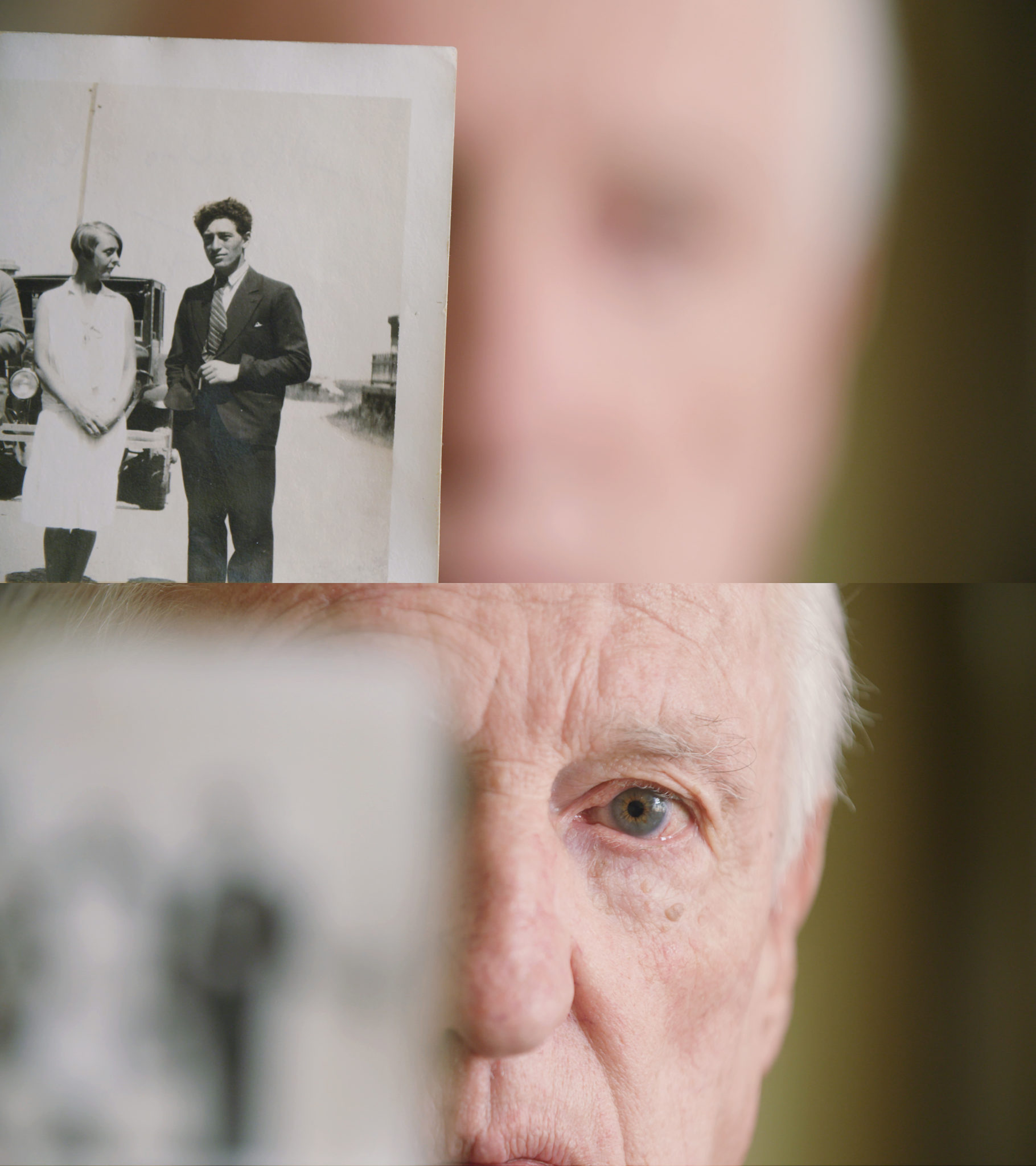
Teresa Hubbard and Alexander Birchler. Flora (installation detail), 2017.
Intuitively, I sense that Flora, as a humanistic portrait of an individual, shows us something of how a person is ultimately more than all the objective facts that accumulate around her-that the project hints at the mystery at the core of personhood. Personhood, as Catholic philosopher Robert Spaemann explains, may be disclosed by means of a reciprocal, generous, and respectful gaze:
The elementary form of such absolute encounter with reality is the intersection of the other’s gaze with mine. I find myself looked at. And if the other’s gaze does not objectify me, inspect me, evaluate me, or merely crave for me, but reciprocates my own, there is constituted in the experience of both what we call “personal existence.”… It is a free decision to treat the other as a real self, not a simulation. What that decision essentially consists in is a refusal to obey the innate tendency of all living things to overpower others. Positively expressed, we may call it “letting-be.” Letting-be is the act of transcendence, the distinctive hallmark of personality. Persons are beings for whom the self-being of another is real, and whose own self has become real to another.
Flora is a brilliantly successful portrait because it is able to communicate something of Flora Mayo’s personhood, and thus momentarily brings its viewers out of
ourselves and into her world. Spaemann writes, “Only the affirmation of other centers of being, through recognition, justice, and love, allows us the distance on ourselves and appropriation of ourselves that is constitutive for persons-in sum, ‘freedom from self.'” The true personal existence of any human being exceeds and outlasts any and all of the worldly, material monuments that even the greatest leave behind. Spaemann again: “Persons exist by being present in each of their acts, but not so inseparably fused with any one of them as to disappear into it altogether.”
Although Flora certainly doesn’t present it this way explicitly, a viewer might also notice that while Alberto left the world his magnificent oeuvre, Flora left only her son. One might well ponder the question: Which would I prefer to leave behind when I am gone? I’m not suggesting that the moral value of having children should be weighed against that of creating great works of art. Rather, I think that the mystery of personhood is precisely why such questions are unanswerable. Flora, the humanistic portrait, shows again how there is something about a person-toward which art can gesture, better than almost anything else-that exceeds our rational understanding. At the deepest and ultimate level, the value of persons (e.g., children) and of representations of persons (e.g., portraits) simply can’t be measured.
Finally, Flora invites its viewers to reflect on the pursuit of justice, classically defined as giving each person his or her due. Flora originated when Hubbard and Birchler noticed the photograph of the two young artists with Flora’s bust of Alberto and started thinking about the discrepancy in their reputations. Part of the appeal of such historical research is the chance to set things right-to give Flora Mayo her due. In this way, historians are like detectives: both do their sleuthing in the name of justice. However, the richness of Flora’s personhood (as revealed especially by David’s memories) also relativizes such questions of institutional accounting: There are more important things in life than being validated by the judgment of history.
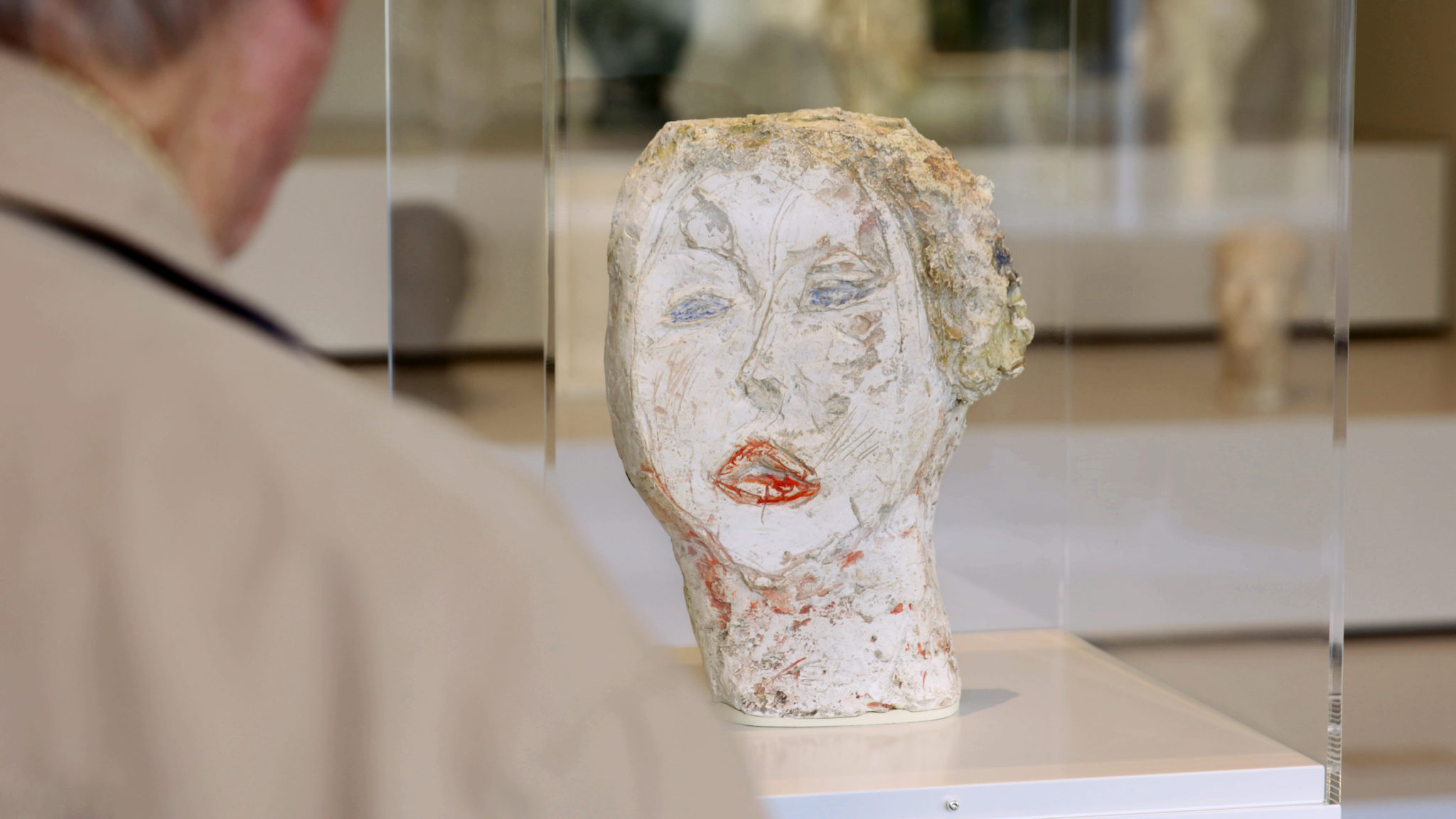
Teresa Hubbard and Alexander Birchler. Flora (installation detail), 2017.
Furthermore, Flora is poignant because, however valuable such efforts are, they inevitably fall short. Nothing on earth can undo what is done or bring back what is gone. Nothing can now give Flora back her dreams or ease her years of pain and hardship. The artistic value of Flora is greater than its limited, though laudable, work toward justice. Much as Flora gives us a portrait of Flora Mayo, whose personhood exceeds the mere facts of her life, so too it gives us a sense that true justice exceeds the limits of what can be practically and ordinarily achieved.
Love, death, justice-thinking about each of these, both with respect to Flora Mayo and more generally, leads to a sense that there is something more about them than can be strictly understood from the facts at hand; in other words, that we can only understand them in negative terms. (Love is not just dropping out of college to support your ailing mother; to struggle against mortality is not simply about achieving the maximum amount before you die; justice is not only about balancing the books publicly and institutionally.) Insofar as a masterful portrait like Flora opens onto the mysterious personhood of its subject-without fully exhausting it-it allows us, by means of such negations, to dimly glimpse, and further imagine, how it would be for persons to flourish in creativity, love, and justice.
Benjamin Lima is an art historian and critic in Dallas. He is editor of Athenaeum Review and has written about Isa Genzken, Elmgreen & Dragset, Alicja Kwade, Mark Dion, Wael Shawky, and other contemporary artists for the Dallas Morning News.





